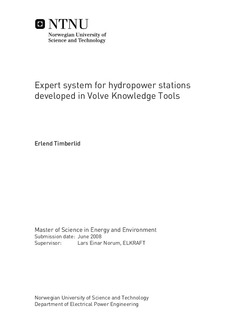| dc.description.abstract | Despite the fact that hydropower stations are equipped with the latest technology in both regulation and remote control, it is not enough to replace the traditional machine expert. The machine expert was a person stationed in the power plant. He had the responsibility for the running and maintenance of the station. This person’s experience and human senses made him crucial for the surveillance of the station. Since the machine expert has now been replaced by electronics and newer technology, there are still areas of his expertise that are to be made. Today’s facilities are highly sophisticated and contain the latest technology, but there are still situations that the surveillance system may fail to intercept. To help the surveillance system detect these situations, the idea is to implement an expert system. In this way the control system can match the machine expert’s skills. Oystein Fjellheim has already done extensive work in finding a suitable development kit. He explored several software packages looking for one to use for this purpose [XXFjellheimM]. The result was the program Volve Knowledge Tools, and the purpose of this report is to further test this program for use in expert systems. This testing considers more advanced and intelligent forms of reading raw data, such as mean calculation, derivation and integration. It also includes testing of how the program learns and uses existing knowledge to solve problems. Since hydropower plants can be constructed in so many ways, it is almost impossible to make an expert system that can include all varieties. One solution is to narrow down the system to a reference system. This system consists of defined components that are common in today’s facilities. Despite this narrowing there are still many processes in a hydropower station that need to be monitored. Voith Siemens has promoted that thermal surveillance is desirable. The reason is that, when performing thermal surveillance, the rest of the system would be indirectly monitored as well. A good example of this would be to monitor the bearings. To detect the condition of a bearing, one has to compare several parameters, of which temperature is the most essential. Two conditions of the bearing are simulated, defective bearing and water in the bearing oil. When constructing the program, three models were made: an ontology model, a causal model and a case model. All models were made pursuant to the reference system. The models are general, but still represent a good approach to the real world. All three models are considered as a good starting point for further work. By developing a simple expert system in Volve Knowledge Tools and using this program for simulations, I gathered a lot of information about how the program operates and functions. After considering advantages versus disadvantages, and the suitability of the program for developing expert systems, I concluded that: Volve Knowledge Tools fulfils the demands that the development an expert system entails. I therefore recommend by Volve Knowledge Tools as the development kit for evolving an expert system in continuing work. | nb_NO |

